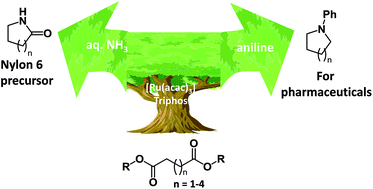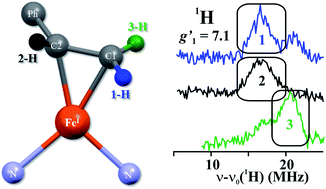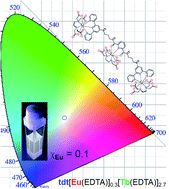Themed collection ISACS: Challenges in Inorganic Chemistry

A new route to N-aromatic heterocycles from the hydrogenation of diesters in the presence of anilines
The hydrogenation of dicarboxylic acids and their esters in the presence of anilines provides a new synthesis of heterocycles.

Chem. Sci., 2017,8, 6911-6917
https://doi.org/10.1039/C7SC01718A
ENDOR characterization of an iron–alkene complex provides insight into a corresponding organometallic intermediate of nitrogenase
Comparison of an iron(I)–alkene complex to a nitrogenase intermediate using ENDOR reveals details of the binding geometry.

Chem. Sci., 2017,8, 5941-5948
https://doi.org/10.1039/C7SC01602F
White-light emission from discrete heterometallic lanthanide-directed self-assembled complexes in solution
Herein, we have developed a white-light-emitting system based on the formation of discrete lanthanide-based self-assembled complexes using a newly-designed ligand. We demonstrate that fine tuning of the lanthanide ions molar ratio in the self-assemblies combined with the intrinsic blue fluorescence of the ligand allows for the successful emission of pure white light with CIE coordinates of (0.33, 0.34).

Chem. Sci., 2017,8, 3419-3426
https://doi.org/10.1039/C7SC00739F
Hydrodeoxygenation of isocyanates: snapshots of a magnesium-mediated C![[double bond, length as m-dash]](https://www.rsc.org/images/entities/char_e001.gif) O bond cleavage
O bond cleavage
Organic isocyanates are readily converted to methyl amine products through their hydroboration with HBpin in the presence of a β-diketiminato magnesium catalyst.
![Graphical abstract: Hydrodeoxygenation of isocyanates: snapshots of a magnesium-mediated C [[double bond, length as m-dash]] O bond cleavage](/en/Image/Get?imageInfo.ImageType=GA&imageInfo.ImageIdentifier.ManuscriptID=C7SC00117G&imageInfo.ImageIdentifier.Year=2017)
Chem. Sci., 2017,8, 3529-3537
https://doi.org/10.1039/C7SC00117G
[Ag115S34(SCH2C6H4tBu)47(dpph)6]: synthesis, crystal structure and NMR investigations of a soluble silver chalcogenide nanocluster
The soluble 115 nuclear silver cluster [Ag115S34(SCH2C6H4tBu)47(dpph)6] was synthesized and fully characterized in solution and in the solid state.
![Graphical abstract: [Ag115S34(SCH2C6H4tBu)47(dpph)6]: synthesis, crystal structure and NMR investigations of a soluble silver chalcogenide nanocluster](/en/Image/Get?imageInfo.ImageType=GA&imageInfo.ImageIdentifier.ManuscriptID=C6SC04578B&imageInfo.ImageIdentifier.Year=2017)
Chem. Sci., 2017,8, 2235-2240
https://doi.org/10.1039/C6SC04578B
Antimony-ligated dysprosium single-molecule magnets as catalysts for stibine dehydrocoupling
The synthesis of antimony-ligated dysprosium SMMs is described in addition to the unexpected reactivity of the SMMs in stibine dehydrocoupling catalysis.

Chem. Sci., 2017,8, 2073-2080
https://doi.org/10.1039/C6SC04465D
Inner-sphere vs. outer-sphere reduction of uranyl supported by a redox-active, donor-expanded dipyrrin
The uranyl(VI) complex UO2Cl(L) of the redox-active diimino-dipyrrin anion, L− is reported and its reactions with inner- and outer-sphere reductants studied.

Chem. Sci., 2017,8, 108-116
https://doi.org/10.1039/C6SC02912D
Transformation of the coordination complex [Co(C3S5)2]2− from a molecular magnet to a potential qubit
We employ ac susceptibility as a probe of small changes of transverse zero-field splitting, revealing that these subtle changes transform [Co(C3S5)2]2− from a molecular magnet to a candidate qubit.
![Graphical abstract: Transformation of the coordination complex [Co(C3S5)2]2− from a molecular magnet to a potential qubit](/en/Image/Get?imageInfo.ImageType=GA&imageInfo.ImageIdentifier.ManuscriptID=C6SC02170K&imageInfo.ImageIdentifier.Year=2016)
Chem. Sci., 2016,7, 6160-6166
https://doi.org/10.1039/C6SC02170K
[3-N2-o-C2B10H11][BF4]: a useful synthon for multiple cage boron functionalizations of o-carborane
Reaction of [3-N2-o-C2B10H11][BF4] with various kinds of nucleophiles gives a very broad spectrum of cage B(3)-substituted o-carborane derivatives, 3-X-o-C2B10H11 (X = OH, SCN, NH2, NO2, N3, CF3, PO(C6H5)2, etc.), and serves as a simple and efficient method for multiple functionalization of o-carborane.
![Graphical abstract: [3-N2-o-C2B10H11][BF4]: a useful synthon for multiple cage boron functionalizations of o-carborane](/en/Image/Get?imageInfo.ImageType=GA&imageInfo.ImageIdentifier.ManuscriptID=C6SC01566B&imageInfo.ImageIdentifier.Year=2016)
Chem. Sci., 2016,7, 5635-5639
https://doi.org/10.1039/C6SC01566B
About this collection
We are delighted to present this web collection which contains selected contributions from the ISACS: Challenges in Inorganic Chemistry meeting held in Manchester, UK in April 2017. Delegates from countries around the world gathered to hear from leading researchers in this exciting field and now we have the opportunity to share with you exciting new research from a number of our plenary speakers and scientific committee members. We hope you enjoy the collection.
Articles in this themed collection will be added below as soon as possible after they are published.
Please return to this page frequently to see the collection grow.